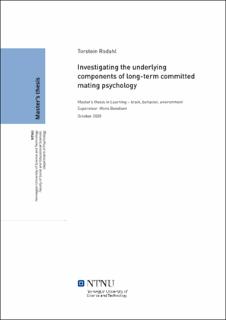| dc.contributor.advisor | Bendixen, Mons | |
| dc.contributor.advisor | Kennair, Leif Edward Ottesen | |
| dc.contributor.author | Rodahl, Torstein | |
| dc.date.accessioned | 2021-09-13T16:19:08Z | |
| dc.date.available | 2021-09-13T16:19:08Z | |
| dc.date.issued | 2020 | |
| dc.identifier | no.ntnu:inspera:64949772:9638462 | |
| dc.identifier.uri | https://hdl.handle.net/11250/2776072 | |
| dc.description.abstract | Menneskelig seksualitet er pluralistisk på den måten at folk både ønsker og opplever flere forskjellige forhold som varierer i forpliktelse og lengde i løpet av livet. Mens individuelle forskjeller i korttidsseksualitet er godt forstått, er de underliggende komponentene som forårsaker langtidsforhold mindre klare. I et snøballutvalg bestående av 183 menn og 423 kvinner fra en likestilt kultur etablerte vi et måleinstrument på langtidsseksualitet basert på de adaptive utfordringene ved langtidsforhold. Gjennom en prinsipiell faktoranalyse bekreftet vi de predikerte komponentene våre, og en konfirmerende faktoranalyse bekreftet at de tre komponentene passet dataen bedre enn en totalskåre. Inkluderingen av de nye komponentene forbedret forklaringsevnen til prediktive modeller for menneskelig langtidsatferd over effekten av to andre etablerte mål i fire av de fem regresjonsanalysene. Forpliktelseskomponenten og eksklusivitetskomponenten, men ikke intimitetskomponenten, forklarte variasjon i utfallsmålene når de var kontrollert for de andre variablene. Forpliktelseskomponenten forklarte variasjon i forholdsstatus, tid som singel, og antall forpliktede forhold. Eksklusivitets komponenten forklarte unik varians i utroskap, forholdsstatus, tid som singel og antall forpliktede forhold. Vi fant også at sosioseksualitet var et sentralt mål for å forstå variasjon i langtidsatferd. Funnene og implikasjonene er diskutert opp mot en multidimensjonal forståelse av menneskelig seksualitet. | |
| dc.description.abstract | Human mating is pluralistic in that most people both desire and experience multiple relationships of varying degrees of commitment and duration throughout their life. While individual variation in short-term uncommitted mating is well understood, the underlying components of long-term committed mating psychology are less so. In a snowball sample of 183 men and 423 women from a high ranked gender-egalitarian culture, we successfully established a multi-component measurement based on the assumed adaptive functions of long-term committed relationships. Principal factor analysis extracted our predicted three-component structure, and a confirmatory analysis confirmed that the three-component structure fit the data better than an overall total score. The inclusion of our new components improved upon the explanatory power of predictive models of human sexuality over and above the effect of contemporary and established measurements of human mating (SOI-R and LTMO-MSOI) in four of our five behavioral outcome variables. The commitment component and the exclusivity component, but not the intimacy component, uniquely explained individual variation when controlled for the other predictors. The commitment component significantly explained variation in relationship status, time spent single, and history of committed relationships. However, it was unrelated to infidelity, which was better explained by the exclusivity component. The exclusivity component also explained unique variation in the probability of being partnered, time spent single, and the number of committed relationships. We also found that sociosexuality was an essential measurement of long-term behavioral outcomes. Findings and implications are discussed in light of the multidimensional conceptualization of sexual strategies. | |
| dc.language | | |
| dc.publisher | NTNU | |
| dc.title | Investigating the underlying components of long-term committed mating psychology | |
| dc.type | Master thesis | |
